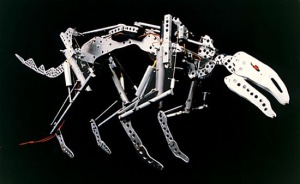First and foremost, what’s your favourite dinosaur?
What a horrific question. It’s like asking a proud parent to choose their favourite child. In my younger days, it was all about the big theropods, tyrannosaurs and the like. But now, I can’t resist the enormous (heh…) charm of sauropods (I prefer the macronarians, Brachiosaurus and the other ‘tall’ sauropods).
Secondly, what’s you favourite (preferably extinct) animal?
A much nicer question question. Pakasuchus kapilimai. As the name suggests it’s a cat-like crocodile. What more could you want? However, honorary mention to Quetzacoatlus (the ‘evil, pin-headed, toothy nightmare monster that wants to eat your soul’, a quote from Darren Naish), because what other flying reptile with a 11m wingspan has a rap about it? Exactly.
What’s your area of ‘expertise’?
I’m not huge expert in anything yet, but I have a passion for biomechanics in the archosaurs (birds, dinosaurs, crocodiles and their ancestors). I’m currently using a lot of computer software to digitally model fossils, so I guess some of my ‘expertise’ lie in digital palaeontology (the shiny-new future, more on that in a future post, probably).
How did you get into palaeontology?
Like most children of the 1990s, I grew up loving Jurassic Park. The scene where Dr. Grant (a personal hero of mine, even as I enter my twenties) first meets the Brachiosaurus is still up there as my favourite movie-moment ever. Even before that, I was an absolute dinosaur-nut. So much so, by the age of 5 I could spell palaeontologist. Since then I’ve never lost that desire to become a palaeontologist. So, after spending primary and secondary school, then college work my behind off I went to the University of Bristol to study on the Palaeontology and Evolution course. I’m now a masters student at the University of Bristol, currently looking for PhD positions to continue my career in ‘dinosaurs’.
What do you do in your spare time?
To be honest, I’m pretty much always reading about palaeontology. Here’s a tip for free: if you want to be an academic you have to be almost obsessed with your subject, if not, you’ll just learn to hate it. In the small amount of time I’m not holed up reading about palaeo (more likely: looking at awesome palaeo art), I’m usually performing/hanging out with Bristol Improv, reading other books, playing video games, or on Twitter (desperately attempting to get #notosuchia trending).
Favourite palaeontological paper?
Ah, I remember it well. It was the first paper I read (all the way back in the first year of my undergraduate degree) that I actually enjoyed reading. It was Rayfield (2004), and I only read it simply because it had Tyrannosaurus rex in the title. But it began my interest in biomechanics (even though I was scared by the maths behind FEA). It was one of the first papers (along with Rayfield et al. 2001) to show the importance of new computational methods in palaeontology. Essentially, I like papers with shiny pictures of fossils (and models of fossils). More recent favourites of mine include:
- Lautenshlager et al. 2013: really cool 3D PDF! (As you can tell, my attention span can only be held on shiny pictures of fossils…)
- Pretty much anything by WitmerLab across the pond in Ohio, USA. Pretty 3D models and some sweet science. Awesome.
You’re a palaeontologist, so you’re like Ross from ‘F.R.I.E.N.D.S’?
If I had a penny for every time someone asks me this, I’d have paid my student loan off years ago. For simplicity, yes, I’m like Ross from Friends.
And yes Jenniston, I am still awaiting your marriage proposal.
Any tips for any budding palaeontologists out there?
If you’re still in school/college/pre-university, work hard! If you’re in university, work even harder! But seriously, if you want to go into an academic career (not just palaeontology) you’re going to have to get used to hard graft. Also, if there’s any dig sites near you (I’m looking at you American readers), then volunteer! Not only is it great fun, but it looks great when you’re applying for uni/palaeo jobs. If you can’t visit dig sites, read around the subject a lot! We know accessing the primary literature is hard (both in terms of paywalls and understanding), but don’t fear! There’s plenty of really accessible blogs (like us!) giving you news and views on all things palaeo. Also, National Geographic magazine occasionally has some nice articles (palaeo related) inside.






